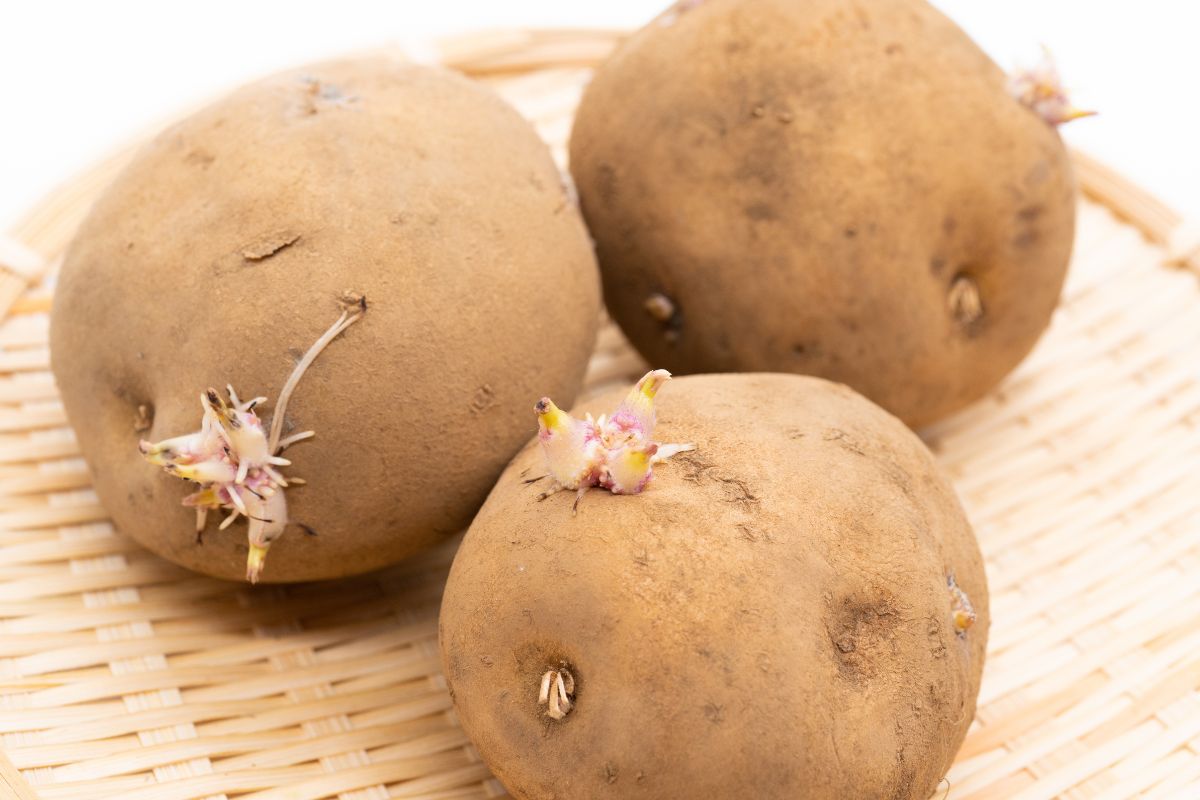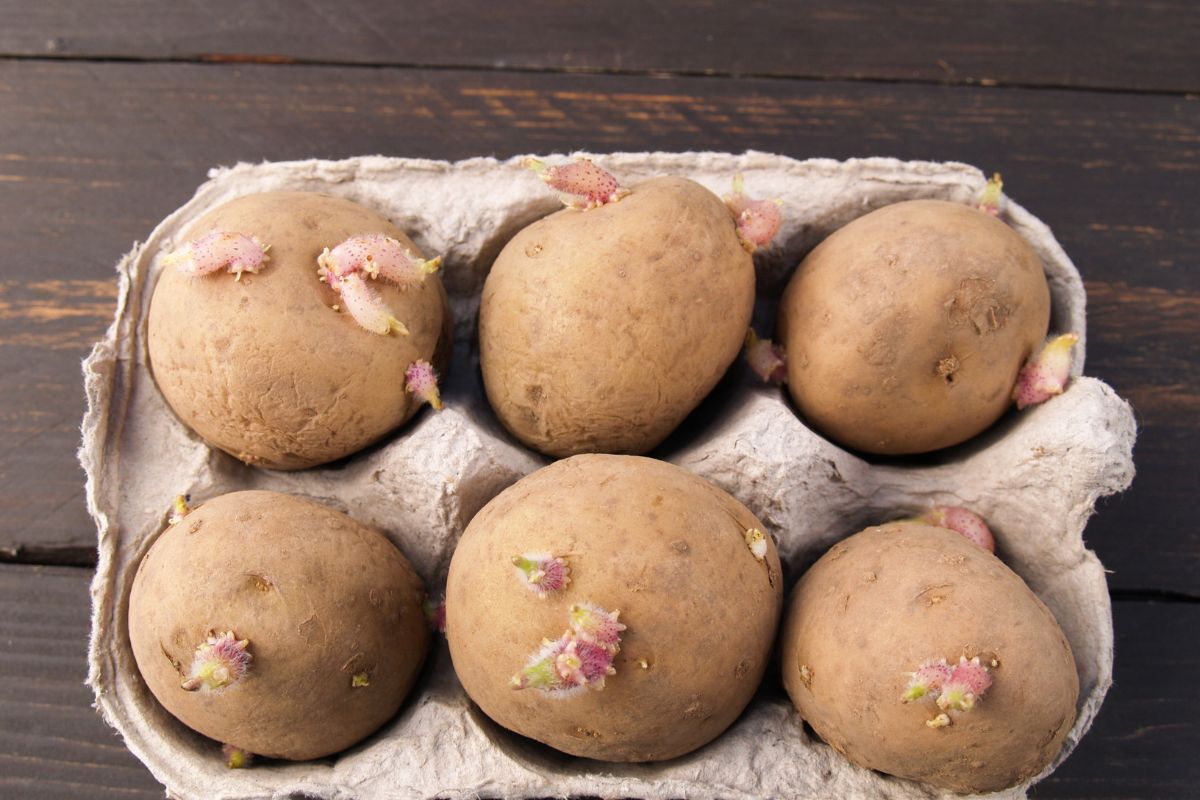It is so annoying when you reach into your sack of potatoes, ready to begin a new recipe, just to find that they are covered in white and green bulbous growths.

This can be a scary sight, and may even convince you to throw them away.
Are sprouted potatoes edible? Will eating a sprout from a potato make you become ill?
In this guide, we will teach you all you need to know about those multicolored sprouts that grow out of potatoes.
Let’s find out if they’re still edible, and how (or, if) you can prevent them from occurring.
So, let’s get started.
What Are The Sprouts On Potatoes?
So, as we’re sure you already know, potatoes grow in soil.
When planted, they sprout underneath the soil, and they are then removed when they are fully grown. This is when they are ready to prepare and consume.
When potatoes are stored away in your kitchen – usually in a sack, a cupboard, or some kind of concealed area – they will begin to sprout again.
Small sprouts will begin to appear from the potato itself, and they can appear either a green, purple, or white color.
Some people call these sprouts ‘eyes’, due to their shape, and the way that they grow out of the potato.
If you were to take sprouting potatoes into your garden, and plant them in some deep soil, you would actually be able to grow some new potatoes.
After all, a potato’s sprouts, or ‘eyes’, are technically seeds.
The sprouts are a sign that the potato is ready to grow tubers.
So, if you are wary of eating a potato with too many sprouts, you could always plant it outside and grow some new ones, rather than throwing it away!
Are Potato Sprouts Poisonous?
Many people become wary once they discover that their potatoes have begun to sprout.
It can be scary to look at, and think about eating, as most people assume that this is a sign that the potato has begun to rot.
In reality, the potato itself is still edible. You will be able to identify a rotting potato by a number of signs:
- A soft, squidgy texture
- Wrinkled, slimy skin
- A strong, bad odor
- Dark spots on the skin
If a potato is completely riddled with sprouts, however, you would be better off throwing it away.
A sprout or two is nothing to worry about, but if the potato has been completely covered with them, you pose a risk to your health by eating it.
Basically, when potatoes sprout, they release glycoalkaloids. These are defensive toxins that protect the potato while it sprouts.
While these sprouts are completely natural, and it is part of the life cycle of a potato, the glycoalkaloids can be toxic to humans when ingested.
Eating these sprouts can cause headaches, gastrointestinal problems, and even neurological issues.
Therefore, you should never eat the sprouts on a potato.
This part of the tuber is poisonous, due to its toxins, and can potentially cause you to become very ill if you were to ingest it.
How To Prepare A Sprouting Potato

As we said earlier, there is no need to throw away a potato if it only has a couple of sprouts growing from it.
You should be wary if it has been covered in sprouts, but if there are only one or two visible, you can still use the potato.
It will also depend on the size of the sprouts themselves.
The best way to determine the full growth of a sprout is to cut into the potato, as they start growing from the inside, and pierce through the skin as they get bigger.
If you cut into the potato, and you cannot see a root, you should be fine simply scraping the sprout off of it.
If you notice a root growing within the potato, however, you will need to carve it out in its entirety.
Some people think that scraping the sprout away is enough, but if the root inside the potato is quite long, and you don’t remove it, you will still ingest the toxins when you eat it.
Your best bet is to only use sprouting potatoes if you are cutting them up for your recipe.
You shouldn’t risk using them as jacket potatoes, even if you scrape the exterior of the sprout away, as the root will still be present on the inside.
When you slice the potato, or even simply peel it, you will be able to identify how deep the root of the sprout is.
Then, using a knife, you can remove it from the potato, and continue preparing it as you normally would.
The Shelf Life Of Potatoes
It can be difficult to precisely determine the shelf life of a potato, as there are so many variables that come into play.
This includes the size of the potato, the type of potato, and where it is being stored (and how well it is being stored).
Tubers can last between one week to two months, depending on these variables.
Some potatoes begin to sprout while they are still in their packaging at the supermarket, but as we mentioned earlier, this does not mean that they have gone bad.
If the potatoes have gone soft, squidgy, and slimy, they smell bad, and they have dark spots, this is a good indication that they have gone bad.
In these cases, you should throw them away immediately.
The better you store your potatoes, the longer they will last. This means storing them in a cool, dark place with plenty of ventilation to breathe, away from any dampness.
Smaller potatoes will deteriorate faster than larger ones, so this is another thing to take into consideration.
All in all, you will just have to keep an eye on your potatoes to make sure you spot exactly when they begin to rot.
Final Thoughts
Just because a potato has begun to sprout, it doesn’t mean you should hastily throw away the whole bag.
If the sprouting is minimal, you will still be able to use those potatoes, providing that you remove the sprouts entirely.
Always be cautious with food, especially if you notice any changes in their appearance, texture, or smell.
As far as sprouting potatoes are concerned, however, you have nothing to worry about. Cut them out, and continue with your recipes as normal!
We hope you found this guide helpful.
- How To Reheat A Cheesesteak - November 5, 2023
- What Are Three Must Have Kitchen Knives? - September 22, 2023
- How To Protect Edges Of Pie Crust - June 15, 2023








